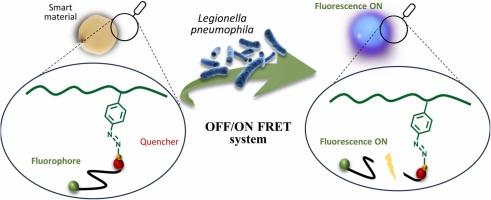利用制备成亲水性薄膜、涂层和电纺纳米纤维的智能含氟聚合物裸眼检测嗜肺军团菌
IF 8
1区 化学
Q1 CHEMISTRY, ANALYTICAL
引用次数: 0
摘要
嗜肺军团菌是一种严重的公共卫生威胁,是军团病等严重疾病的罪魁祸首。传统的检测方法往往耗费大量人力、时间,并且需要复杂的设备。本研究介绍了通过蛋白酶活性对嗜肺菌进行肉眼检测的智能含氟聚合物材料。这些材料由亲水性薄膜、纤维素涂层线性共聚物和电纺纳米纤维制备而成,采用关/开 FRET 系统,在紫外光下与嗜肺病毒蛋白酶作用后发出荧光。表征证实了多肽底物的成功固定及其对蛋白酶的反应。传感器显示出中等到较高的灵敏度和特异性,薄膜、共聚物和纳米纤维形式的检测限分别为 2.91×105、3.64×10⁵ 和 4.04×105 CFUs/mL。交叉反应测试发现只有铜绿假单胞菌是干扰物。这种新方法可快速、简单、经济地检测嗜肺菌,在紫外光下检测结果可见,适用于临床和环境样本。它凸显了更广泛的病原体检测应用潜力。本文章由计算机程序翻译,如有差异,请以英文原文为准。

Naked-eye detection of Legionella pneumophila using smart fluorogenic polymers prepared as hydrophilic films, coatings, and electrospun nanofibers
Legionella pneumophila is a significant public health threat, responsible for severe diseases such as Legionnaires’ disease. Traditional detection methods are often labour-intensive, time-consuming, and require sophisticated equipment. This study introduces smart fluorogenic polymeric materials for the naked-eye detection of L. pneumophila via protease activity. These materials, prepared as hydrophilic films, cellulose-coated linear copolymers, and electrospun nanofibers, operate on an OFF/ON FRET system, emitting fluorescence under UV light upon interaction with L. pneumophila proteases. Characterisation confirmed the successful immobilisation of the peptide substrate and its response to proteases. The sensors showed moderate to high sensitivity and specificity, with detection limits of 2.91 × 105, 3.64 × 10⁵, and 4.04 × 105 CFUs/mL for the film, copolymer, and nanofiber formats, respectively. Cross-reactivity tests identified only Pseudomonas aeruginosa as an interferent. This novel approach offers rapid, simple, and cost-effective L. pneumophila detection with visible results under UV light, suitable for clinical and environmental samples. It highlights the potential for broader pathogen detection applications.
求助全文
通过发布文献求助,成功后即可免费获取论文全文。
去求助
来源期刊

Sensors and Actuators B: Chemical
工程技术-电化学
CiteScore
14.60
自引率
11.90%
发文量
1776
审稿时长
3.2 months
期刊介绍:
Sensors & Actuators, B: Chemical is an international journal focused on the research and development of chemical transducers. It covers chemical sensors and biosensors, chemical actuators, and analytical microsystems. The journal is interdisciplinary, aiming to publish original works showcasing substantial advancements beyond the current state of the art in these fields, with practical applicability to solving meaningful analytical problems. Review articles are accepted by invitation from an Editor of the journal.
 求助内容:
求助内容: 应助结果提醒方式:
应助结果提醒方式:


